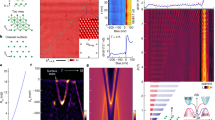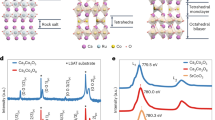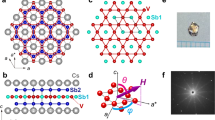Abstract
The iron pnictide and chalcogenide compounds are a subject of intensive investigations owing to their surprisingly high temperature superconductivity1. They all share the same basic building blocks, but there is significant variation in their physical properties, such as magnetic ordered moments, effective masses, superconducting gaps and transition temperature (Tc). Many theoretical techniques have been applied to individual compounds but no consistent description of the microscopic origin of these variations is available2. Here we carry out a comparative theoretical study of a large number of iron-based compounds in both their magnetic and paramagnetic states. Taking into account correlation effects and realistic band structures, we describe well the trends in all of the physical properties such as the ordered moments, effective masses and Fermi surfaces across all families of iron compounds, and find them to be in good agreement with experiments. We trace variation in physical properties to variations in the key structural parameters, rather than changes in the screening of the Coulomb interactions. Our results also provide a natural explanation of the strongly Fermi-surface-dependent superconducting gaps observed in experiments3.
This is a preview of subscription content, access via your institution
Access options
Subscribe to this journal
Receive 12 print issues and online access
$259.00 per year
only $21.58 per issue
Buy this article
- Purchase on Springer Link
- Instant access to full article PDF
Prices may be subject to local taxes which are calculated during checkout



Similar content being viewed by others
Change history
23 September 2011
In the version of this Letter originally published, BaFe2Se2 should have been BaFe2As2 in Figs 1 and 2. This error has been corrected in all versions of the Letter.
References
Kamihara, Y. et al. Iron-based layered superconductor La[O1−xFx]FeAs (x=0.05–0.12) with Tc=26 K. J. Am. Chem. Soc. 130, 3296–3297 (2008).
Paglione, J. & Greene, R. L. High-temperature superconductivity in iron-based materials. Nature Phys. 6, 645–658 (2010).
Ding, H. et al. Observation of Fermi-surface-dependent nodeless superconducting gaps in Ba0.6K0.4Fe2As2 . Europhys. Lett. 83, 47001 (2008).
Haule, K. & Kotliar, G. Coherence-incoherence crossover in the normal state of iron-oxypnictides and importance of the Hund’s rule coupling. New J. Phys. 11, 025021 (2009).
Mazin, I. I & Johannes, M. D. A key role for unusual spin dynamics in ferropnictides. Nature Phys. 5, 141–145 (2009).
Bao, W. et al. Incommensurate magnetic order in the α-Fe(Te,Se) superconductor systems. Phys. Rev. Lett. 102, 247001 (2009).
Yu, W. Q. et al. 23Na and 75As NMR study of antiferromagnetism and spin fluctuations on NaFeAs single crystals. Phys. Rev. B 83, 132501 (2011).
Huang, Q. et al. Magnetic order in BaFe2As2, the parent compound of the FeAs based superconductors in a new structural family. Phys. Rev. Lett. 101, 257003 (2008).
Li, H-F. et al. Phase transitions and iron-ordered moment form factor in LaFeAsO. Phys. Rev. B 82, 064409 (2010).
Xiao, Y. et al. Magnetic order in CaFe1−xCoxAsF (x=0, 0.06, 0.12) superconductor compounds. Phys. Rev. B 79, 060504 (2009).
Xiao, Y. et al. Neutron diffraction study on phase transition and thermal expansion of SrFeAsF. Phys. Rev. B 81, 094523 (2010).
Zhao, J. et al. Spin and lattice structure of single crystal SrFe2As2 . Phys. Rev. B 78, 140504 (2008).
Goldman, A. I. et al. Lattice and magnetic instabilities in CaFe2As2: A single crystal neutron diffraction study. Phys. Rev. B 78, 100506 (2008).
Yin, Z. P., Haule, K. & Kotliar, G. Magnetism and charge dynamics in iron pnictides. Nature Phys. 7, 294–297 (2011).
de’ Medici, L. et al. Orbital-selective Mott transition out of band degeneracy lifting. Phys. Rev. Lett. 102, 126401 (2009).
Hu, W. Z. et al. Optical study on the spin-density wave properties in single crystalline Na1−δFeAs. Phys. Rev. B 80, 100507 (2009).
Hu, W. Z. et al. Origin of the spin density wave instability in AFe2As2 (A=Ba, Sr) as revealed by optical spectroscopy. Phys. Rev. Lett. 101, 257005 (2008).
Chen, Z. G. et al. Optical spectroscopy study on single crystalline LaFeAsO. Phys. Rev. B 81, 100502 (2010).
Qazilbash, M. M. et al. Electronic correlations in the iron pnictides. Nature Phys. 5, 647–650 (2009).
Tamai, A. et al. Strong electron correlations in the normal state of FeSe0.42Te0.58 . Phys. Rev. Lett. 104, 097002 (2010).
Yamasaki, A. et al. Electron correlation in FeSe superconductor studied by bulk-sensitive photoemission spectroscopy. Phys. Rev. B 82, 184511 (2010).
Borisenko, S. V. et al. Superconductivity without magnetism in LiFeAs. Phys. Rev. Lett. 105, 067002 (2010).
Yi, M. et al. Unconventional electronic reconstruction in undoped (Ba,Sr)Fe2As2 across the spin density wave transition. Phys. Rev. B 80, 174510 (2009).
Wang, Q. et al. Uniaxial ‘nematic-like’ electronic structure and Fermi surface of untwinned CaFe2As2. Preprint at http://arxiv.org/abs/1009.0271 (2010).
Okada, I. & Yosida, K. Singlet ground state of the localized d-electrons coupled with conduction electrons in metals. Prog. Theor. Phys. 49, 1483–1502 (1973).
Zhang, Y. et al. Orbital characters of bands in iron-based superconductor BaFe1.85Co0.15As2 . Phys. Rev. B 83, 054510 (2011).
Yi, M. et al. Electronic structure of the BaFe2As2 family of iron-pnictide superconductors. Phys. Rev. B 80, 024515 (2009).
Acknowledgements
Z.P.Y. and G.K. were supported by NSF DMR-0906943; K.H. was supported by NSF DMR-0746395. Part of the work (Z.P.Y.) was carried out under the auspices of a DoD National Security Science and Engineering Faculty Fellowship, through AFOSR grant FA 9550-10-1-0191. Acknowledgement (K.H.) is made to the donors of the American Chemical Society Petroleum Research Fund for partial support of this research.
Author information
Authors and Affiliations
Contributions
Z.P.Y. carried out the calculations. K.H. developed the DMFT code. Z.P.Y., K.H. and G.K. analysed the results and wrote the paper. Z.P.Y. led the project.
Corresponding author
Ethics declarations
Competing interests
The authors declare no competing financial interests.
Supplementary information
Supplementary Information
Supplementary Information (PDF 1151 kb)
Rights and permissions
About this article
Cite this article
Yin, Z., Haule, K. & Kotliar, G. Kinetic frustration and the nature of the magnetic and paramagnetic states in iron pnictides and iron chalcogenides. Nature Mater 10, 932–935 (2011). https://doi.org/10.1038/nmat3120
Received:
Accepted:
Published:
Issue Date:
DOI: https://doi.org/10.1038/nmat3120
This article is cited by
-
Infinite-layer nickelates as Ni-eg Hund’s metals
npj Quantum Materials (2023)
-
Charge order driven by multiple-Q spin fluctuations in heavily electron-doped iron selenide superconductors
Nature Communications (2023)
-
Stability of the interorbital-hopping mechanism for ferromagnetism in multi-orbital Hubbard models
Communications Physics (2023)
-
Comparative study of adaptive variational quantum eigensolvers for multi-orbital impurity models
Communications Physics (2023)
-
Kondo interaction in FeTe and its potential role in the magnetic order
Nature Communications (2023)



